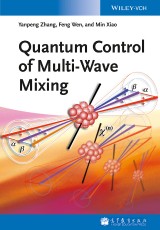Details

Quantum Control of Multi-Wave Mixing
1. Aufl.
|
138,99 € |
|
| Verlag: | Wiley-VCH |
| Format: | EPUB |
| Veröffentl.: | 17.07.2013 |
| ISBN/EAN: | 9783527672387 |
| Sprache: | englisch |
| Anzahl Seiten: | 352 |
DRM-geschütztes eBook, Sie benötigen z.B. Adobe Digital Editions und eine Adobe ID zum Lesen.
Beschreibungen
Multi-wave mixing gives rise to new frequency components due to the interaction of light signals with a suitable nonlinear medium. In this book a systematic framework for the control of these processes is used to lead readers through a plethora of related effects and techniques.
Chapter 1: Introduction <br> 1.1 Suppression and enhancement conditions <br> 1.2 Fluorescence in MWM<br> 1.3 MWM Process in the Optical Cavity<br> 1.4 Photonic band gap <br> 1.4.1 Periodic Energy level<br> 1.4.2 Method of transfer matrix<br> 1.4.3 Nonlinear Talbot Effect<br> 1.5 Summary<br> <br> Chapter 2: MWM Quantum Control via Electromagnetically Induced Transparency <br> 2.1 Control of multi-transparency windows via dark-state phase manipulation<br> 2.2 Controlled multi-wave mixing via interacting dark states in a five-level system <br> 2.3 EIT-assisted Four-wave Mixing Process in the Diamond-type Four-level Atomic Systerm<br> 2.4 Dressed odd-order multi-wave mixing in five-level atomic system <br> 2.5 Observation of eight-wave mixing via electromagnetically induced transparency<br> 2.6 Interference of three multi-wave mixings via electromagnetically induced transparency<br> 2.7 Summary<br> <br> Chapter 3: Controllable Autler-Townes Splitting of MWM Process via Dark State <br> 3.1 Measurement of ac-Stark shift by a two-photon dressing process via four-wave mixing<br> 3.2 Autler-Townes splitting of Four-Wave Mixing image<br> 3.3 Evidence of Autler-Townes splitting in high-order nonlinear processes<br> 3.4 Observation of Autler-Townes splitting in six-wave mixing<br> 3.5 Multi-wave mixing Autler-Townes splitting in the five-level atomic system<br> 3.6 Summary<br> <br> Chapter 4: Controllable Enhancement and Suppression of MWM Process via Dark State<br> 4.1 Enhancement and suppression of four-wave mixing in EIT window<br> 4.2 Switching between enhancement and suppression of four-wave mixing via a dressing field<br> 4.3 Controlling the transition of bright and dark states via scanning dressing field<br> 4.4 Multi-dressing Interaction of Four-wave Mixing in Three-level Atomic System<br> 4.5 Enhancement and suppression of two coexisting six-wave-mixing processes<br> 4.6 Switching between enhancement and suppression of four-wave mixing via the power (zyr)<br> 4.7 Controlling cascade dressing interaction of four-wave mixing image<br> 4.8 Summary<br> <br> Chapter 5: MWM Process with Polarizable Dark State<br> 5.1 Controlling enhancement and suppression of four-wave mixing via polarized light<br> 5.2 Coexisting polarized four-wave mixings in two-level atomic system<br> 5.3 Polarization Dressings of Four-wave Mixing Process in a V-type Three-level Atomic System<br> 5.3 Observation of polarization-controlled spatial splitting of four-wave mixing in a three-level atomic systems<br> 5.4 Polarized SWM Suppression and Enhancement<br> 5.5 Summary<br> <br> Chapter 6: Exploring Non-Classical Properties of MWM Process<br> 6.1 Opening Fluorescence Channels via Dual Electromagnetically Induced Transparency Windows<br> 6.2 Enhancement and Suppression of Four-Wave Mixing Fluorescence<br> 6.3 Three-field noise correlation via third-order nonlinear optical processes<br> 6.4 Controllable four-wave mixing transmission signal inside an optical cavity<br> 6.5 Continuous variable entanglement between FWM and SWM signal<br> 6.6 Summary<br> <br> Chapter 7: Coherent Modulation of Photonic Band Gap in FWM Process<br> 7.1 Surface solitons of four-wave mixing in electromagnetically induced lattice<br> 7.2 Four-wave mixing and Six-wave mixing with Talbot effect<br> 7.3 Spatial Interplay of Two Four-Wave Mixing Images<br> 7.4 Observation of multi-component spatial vector solitons of four-wave mixing<br> 7.5 Summary<br> <br> Chapter 8: Optical Routing and Space Demultiplexer of MWM Process <br> 8.1 Experimental demonstration of optical switching and routing via four-wave mixing spatial shift<br> 8.2 All-optical routing and space demultiplexer via four-wave mixing spatial splitting<br> 8.3 Circulator of FWM vortex<br> 8.5 Summary<br> <br> References<br> Index
<p>“This text, supported by the two previous volumes published by the authors, will bring readers to the forefront of activity in this field.” (<i>Optics & Photonics News</i><i>, 7</i> <i>February 2014)</i></p>
<b>Yangpeng Zhang</b> received his PhD in Physics Electronics and Optical Electronics in 2000 and is now Tengfei Chair Professor at Xi'an Jiaotong University. He received numerous national science and technology young researchers awards for his theoretical studies on photonics, especially wave mixing. More than 100 papers in peer review journals and two books on all aspects of multi-wave mixing make him an ideal author for this topic.<br /><br /><b>Feng Wen</b> is currently PhD student at Xi'an Jiaotong University.<br /><br /><b>Min Xiao</b> is Distinguished Professor of Physics and holder of the 21st Century Chair in Nanotechnology at the University of Arkansas. He held positions in Shanxi University, China, and the Massachussetts Institute of Technology, received the NSF Young Investigator Award in 1994, and is a Fellow of the American Physical Society and the Optical Society of America. With more than 240 publications on related topics he is one of the experts in the field of multi-wave mixing.

















